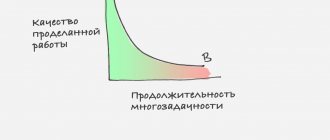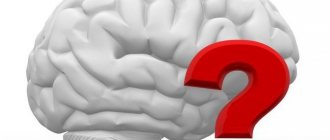1.General information
By memory we mean the ability of the human brain to receive and fix (perceive and actually remember), retention (retention) and reproduction (voluntary actualization at the right moment) of any information. Information, in turn, is understood as any signal or set of signals about the state of the external and internal world, about the past, present and future of these worlds, their changes (in the broadest sense - from the universal Big Bang to a slight mood swing in the human carrier). memory).
This stream of messages enters the brain constantly and continuously; it requires not only the registration, so to speak, of technical information (dates, numbers and other parameters), but also the functioning of many other types of memory - color, musical, tactile, emotional, etc.; in other words, the so-called “memory of the heart” is actually also memory of the brain. Accordingly, with such volumes of incoming information as the sense organs provide us, attention (the ability to focus mental activity and the “ray” of consciousness on any external or internal object) and the analytical centers of the cerebral cortex, which are engaged in extracting meanings, meanings, conclusions, forecasts from the information flow, i.e. processing of information - memory must have a number of special properties and qualities, otherwise it will simply be overloaded. One of the most important of these properties, along with the ability for fixation-retention-reproduction, is selectivity - the selectivity of memory, due to which not all, but only the necessary information is retained and stored in the brain, and the “filters” that evaluate and implement such a need are are divided into objective (developed during evolution - for example, genetic knowledge that it is better to bypass a snake crawling towards you by the tenth road, and you should only jump down from a safe height) and subjective (having personal significance specifically for a given person - for example, PIN - a code for a bank card or the smell of grandma's pies from distant childhood). An important memory protection mechanism is also the deletion of long-term unused data - in exactly the same way as spam is automatically deleted from an email account after a certain period of time.
The organization and functioning of memory, in general, is an extremely complex (among the most complex of all known to man) phenomenon, since this metafunction is localized in a relatively small volume of the cranium and operates thanks to purely biological, as yet far from fully understood mechanisms and principles, based which lie electrochemical, neurotransmitter, biochemical processes, the creation and debugging of which took organic evolution, in total, several billion years (this is not a typo: exactly billions of years, not millions, since the mechanisms for retaining and storing some elementary information were laid , apparently, even in the very first macromolecules that we could call living - for without such a remembering, storing and updating block, living matter would not exist at all).
It is obvious that with such a complex organization and versatility of memory, from time to time something in it is weakened and restored, improved through continuous training and use - or destroyed, disintegrates under the influence of harmful factors and unfavorable conditions. Human memory as such is studied by many sciences, not only the humanities, but also purely technical ones, but medicine is primarily interested, of course, in pathological conditions and memory disorders in terms of their causes, development mechanisms and correction possibilities.
According to various estimates, in the general human population, from one quarter to one third of the population suffers from one or another disorder and memory impairment, however, these estimates can only be taken as very approximate, since we still do not have a sufficiently clear idea of what it is, In general, this is the ideal memory of a person, and why should it correspond to exactly those standards that, in fact, we ourselves introduced for it.
A must read! Help with treatment and hospitalization!
Memory losses
Encephalitis
Diabetes
13659 21 August
IMPORTANT!
The information in this section cannot be used for self-diagnosis and self-treatment.
In case of pain or other exacerbation of the disease, diagnostic tests should be prescribed only by the attending physician. To make a diagnosis and properly prescribe treatment, you should contact your doctor. “Memory lapses” mean complete or partial loss of memories.
However, such an interpretation may imply memory loss, or may indicate an inability to remember this or that fact at a given moment.
Varieties
Memory is ensured by the functional activity of all parts of the brain and includes various processes - memorization, storage (or, conversely, forgetting), recognition and reproduction. Disruption of any of these processes will lead to memory defects.
It is the fight against forgetting (an important process that protects the brain from excess information) that ensures the retention of important data.
Two more processes – recognition and reproduction – make it possible to “bring to the surface” the required information.
Thus, memory loss, or lapses, refers to the inability to recognize or reproduce data stored in the brain. Memory lapses (or amnesia) may occur over time. Retrograde
amnesia is characterized by the inability to remember events preceding an injury or illness;
anterograde amnesia
is accompanied by loss of memory for events that occurred after the illness.
There are also retroanterograde
amnesia (a combination of the first two) and
fixation
, characterized by the inability to remember current events.
If memory for events at the time of injury or illness is lost, they speak of congrade
amnesia.
Possible reasons
Memory lapses do not always indicate any disease.
Rapidly changing information is absorbed only by short-term memory and is stored for several days. An example of such memorization is preparation for an exam: a large amount of data is absorbed in a short time and just as quickly disappears from memory.
Storing information for long periods of time requires processing and encoding.
Only after this the necessary data is recorded in the brain structures.
In the presence of psychological factors
(stress, nervous overstrain) or constant fatigue and lack of sleep, concentration is disrupted, which impairs the memorization process.
Memory lapses often occur as a defensive reaction to emotional stress.
A typical example of this condition is sudden memory loss during exams or when speaking in front of an audience. These failures refer to transient memory impairments, but in some cases they may indicate a circulatory disorder in the area of the posterior cerebral arteries, which most often occurs with alcoholism and drug addiction
.
Damage to even small areas of the brain due to traumatic brain injury
also leads to memory loss or blackouts.
In this case, retrograde amnesia occurs, which lasts several hours before the injury. Longer fixation amnesia is also possible - several days immediately after the injury, which is noted when the patient is clearly conscious. A few days after the injury, memory is restored in most cases. Surgeries on the temporal lobes of the brain
lead to transient memory impairment .
Patients with epilepsy
forget not only the seizure itself, but also the short period of confusion after it.
In some cases, it is precisely such memory lapses that give reason to suspect epilepsy during non-convulsive seizures.
Memory disorders may be caused by metabolic disorders in the central nervous system.
Deterioration of brain function occurs with a lack of oxygen due to cardiopulmonary failure
, toxic damage due to
liver and kidney failure
.
Oxygen starvation of the brain after a sharp rise or fall in blood pressure is often accompanied by a sharp deterioration in memory.
The same effect has a decrease in glucose levels during fasting and
diabetes
. In addition, with diabetes mellitus, angiopathy develops - damage to blood vessels, which aggravates nutritional deficiency.
A sharp deterioration in memory with failures occurs with hypothyroidism
, which is caused by a lack of iodine in the body.
Deficiency of vitamin B12 and folic acid
is also accompanied by memory impairment.
Vitamin B12 is necessary for the regeneration of myelin, a substance that covers nerve fibers and ensures their functioning.
Destruction of the myelin layer is accompanied by slowing of nerve impulses and memory impairment. Memory may be affected in patients taking certain medications
. These include anticholinergics (atropine, scopolamine, platiphylline, metallisir), antidepressants and antipsychotics. Steroid hormones have a destructive effect on brain structures and, accordingly, memory. Recent studies show that people who take steroid hormones for a long time (for example, bodybuilders) have serious problems with visuospatial memory. Information about the negative effect of steroid hormones on memory should also be taken into account in patients with bronchial asthma and arthritis.
Tumors
, infectious diseases that lead to damage to the central nervous system sometimes have an irreversible effect on memory.
Such diseases include encephalitis
and
meningitis
.
Inflammation of the membranes and tissue of the brain leads to the destruction of nerve structures and, as a result, to impairment of cognitive activity, speech and memory.
There are memory impairments associated with age.
Normally, the first signs of memory decline appear after 50 years of age, which is associated with a weakening of concentration and a decrease in the processes of encoding information. However, if memory loss progresses sharply, more serious illnesses may be suspected. First of all, memory loss can occur with senile, or senile, dementia. With dementia, diffuse damage occurs to the cerebral cortex (for example, in Alzheimer's disease
) or subcortical structures of the brain (
Parkinson's disease, Huntington's chorea, multiple sclerosis, encephalopathy
).
The earliest sign of Alzheimer's disease is loss of memory for recent events.
This symptom may later be accompanied by speech and cognitive impairments. As the disease progresses, loss of fixation, anterograde and retrograde memory develops. Memory for events that happened a long time ago is retained for the longest time. With Parkinson's disease and multiple sclerosis, a person spends a lot of time remembering past events or facts. At the same time, he gets tired quickly, it is difficult for him to remember new information or master motor skills.
With repeated repetition of new material and the establishment of semantic analogies, the memorization process becomes easier, but requires constant reinforcement.
Diagnostics and examination To diagnose the causes of memory impairment, an assessment of the patient’s mental state, a thorough analysis of the data revealed during the survey, and the dynamics of the development of the disease are necessary. Significant information can be obtained using various laboratory tests and instrumental examinations, as well as assessing the patient’s neurological status. Brain CT and MRI data are used as an objective criterion.
2. Reasons
The reasons for the weakening, distortion, complete loss or, conversely, accelerated functioning of various types of memory are truly endless, they range from ordinary fatigue or unusual love to still poorly understood neurodegenerative or neurometabolic diseases. However, if we clearly divide memory disorders into situational (transient, i.e., those that quickly and completely disappear when conditions are normalized), on the one hand, and purely pathological, on the other, then doctors most often point to direct or indirect causes of mnestic disorders observe:
- acute, paroxysmal or chronic disorders of cerebrovascularization (blood supply to the brain) in their entire spectrum, including strokes;
- the use of intoxicating drugs of any effect and state of aggregation (including the smoldering sublimation of dried tobacco leaves, to enhance the carcinogenic effect, impregnated with flavorings and passed, already in the form of a toxic gaseous substance, through a chemical enrichment with heavy elements - the so-called filter);
- traumatic brain injuries, incl. including in the long-term anamnesis (the long-term consequences of TBI are in some cases more severe than the immediate ones);
- atrophic, degenerative-dystrophic, demyelinating and other dementing (i.e., debilitating) processes, incl. age-related and genetic diseases;
- oncological processes in the central nervous system;
- purely mental disorders, in the structure of which there are often changes in memory functions without organic damage to the central nervous system accessible to diagnosis (amnesia, hypermnesia, etc.);
- somatic factors - hypovitaminosis, asthenia, the presence of chronic diseases, extensive surgical interventions with massive blood loss, etc.;
- neuroinfections;
- psychological factors - situations of chronic stress, mental overload, PTSD and many others.
Visit our Neurology page
The main causes of loss of concentration and memory
Conventionally, they can be divided into 2 categories. The first includes those that are voluntarily or unwittingly “provoked” by the person himself and those that are caused by a number of diseases.
Causes associated with poor lifestyle
Mental fatigue due to a large amount of information. Daily, long hours of “surfing” on the Internet is one of the main causes of mental stress.
This is interesting! If you are told that multitasking is very effective and you should strive for it, don’t believe it! It is a myth. It has already been scientifically proven that a person cannot do several things at the same time, because his brain begins to “program malfunctions”, like a regular computer with a processor overloaded with tasks.
Chronic stress and emotional burnout. One of the main reasons for decreased concentration, both in children and adults.
Abuse of coffee. In small quantities, coffee stimulates the brain, but its excess, on the contrary, leads to increased fatigue, inability to concentrate and memory impairment.
Long-term, uncontrolled use of medications that correct the activity of the nervous system: antidepressants, tranquilizers, sedatives, barbiturates, etc.
Alcohol, nicotine, drugs. Such substances have the most negative effect on the functioning of the brain, even to the point of destroying its cells.
Violation of the regime. During sleep, nerve cells not only regenerate, but also form new neural connections. Without enough sleep day after day, you force your brain to work “to wear out”, which has the most negative effect on concentration.
Poor nutrition. Convenience foods, cheap food of synthetic origin, “chemical” drinks and sweets - all of this contains substances harmful to health, many of which tend to accumulate in the body. Gradually, they begin to negatively affect memory and the ability to concentrate on a specific task.
3. Symptoms and diagnosis
In various clinical disciplines (neurology, psychiatry, pathopsychology) slightly different classifications of mnestic disorders are used; These classifications, as a rule, are very extensive, ramified, and in full, with all their elements and subtypes, have real practical significance only for specialists.
Let us only note that with the observed number of options and clinical diversity of memory disorders, it is time to organize a separate medical specialty for their study, and it would be far from being the narrowest.
The main classes of mnestic disorders include:
Hypomnesia. In fact, the term covers the entire range of different variants of weakening (not to be confused with the complete absence) of memory, including its different modalities and different degrees of severity of disorders.
The most informative in terms of diagnosing mnestic disorders - if we talk about the nature, severity, nuances of selectivity, exhaustion, emotional-volitional and motivational components - is the extensive and developed methodology of medical (clinical) psychology, especially its neuropsychological branch.
To confirm, exclude or clarify the organic, cellular and tissue nature of memory disorders, instrumental methods are prescribed: tomography, X-ray, ECG, Doppler ultrasound, angiography, etc.; to clarify biochemical characteristics - laboratory tests.
About our clinic Chistye Prudy metro station Medintercom page!
Lecture 5. Memory, attention, and intelligence disorders
Attention is the concentration of the individual on certain objects and activities.
Passive – this type of orientation reflex
· active – with purposeful activity
· selective – selection of 1 signal from a number of similar ones.
Qualities of attention:
- ability to concentrate
- volume
- sustainability
- switchability
Attention has an external or internal focus.
Attention disorders:
1. Exhaustion - the patient quickly gets tired and cannot continue to work, occurs with asthenia (somatic and infectious diseases), neuroses, organic disorders.
2. Distractibility - quickly switching from one object to another. Occurs in hyperdynamic Sd at primary school age, manic Sd, hypomanic states.
Aprosexia is a complete inability to concentrate attention, characteristic of organic damage to the frontal lobes and early childhood schizophrenia.
3. Inertia (rigidity) – difficulty switching from one object to another, characteristic of epilepsy and organic disorders.
Attention is studied using the observation method, psychological techniques: counting according to Kripelin (subtract from 100 by 7, 13, 17 sequentially), Bourdon's proof test (crossing out for a while), Schulte tables (look for numbers from 1 to 25).
Memory is a reflection of past experience, contained in recollection, preservation and reproduction of what was previously experienced and done. Includes 3 stages: memorization, storage, playback.
Memory classification:
1. Depending on the senses: visual, auditory, tactile, gustatory, proprioceptive.
2. By duration - operational (for a few seconds), short-term (for current events), long-term (saved for important events, information repeated many times).
The mechanisms of memory are not fully understood. Short-term memory is the circulation of excitation in the hippocampus, limbic system, RF, and temporal region. Long-term memory is information recorded on RNA and DNA.
Memory disorders:
· reversible – observed only during illness, for example, with neuroses.
· irreversible – in case of organic disorders.
Quantitative:
1. Hypermnesia – remembering information for a long time, clearly in detail. Occurs in cases of intellectual impairment (the imbecile operates in his mind with 3-4-digit numbers), in coma, and in severe infectious diseases.
2. Hypomnesia – weakened memory. Occurs in epilepsy, neuroses, organic disorders, schizophrenia.
Ribot's law : events that happened recently are remembered worse and erased faster than events from childhood and adolescence.
Anekphoria is difficulty reproducing information.
3. Amnesia – absence of memories for a certain period.
Retrograde – events that immediately preceded an emergency event or illness are omitted.
Anterograde – events that followed the incident are omitted.
Congradnaya – loss of memories during traumatic events.
Delayed – amnesia occurs some time after traumatic events.
Affectogenic – events occur during the period of affect.
Fixation – the memorization of current events is impaired, life becomes simultaneous. Often accompanied by amnestic disorientation, when the patient is completely unable to orient himself in time and place. The person does not remember what day it is, what and when he ate, what he did before, and does not know the way home. Occurs in atrophic diseases of the brain (Alzheimer's disease), CAS, severe head injury.
Total - the person does not remember anything at all.
Quality:
1. Confabulations - events that did not happen, and with which gaps in memory are filled. These are memory hallucinations. Replacement with false memories occurs unintentionally; the person completely believes in it. Sometimes fictitious events are supplemented by delusions (schizophrenia, organic psychoses).
2. Pseudo-reminiscences - gaps in memory are filled with events that actually happened once, but they are transferred in place and time. Occurs in organic disorders.
3. Ecmnesia - the patient seems to be living in his past life. Occurs in CAS, hysteria, schizophrenia.
4. Cryptomnesia - involuntary plagiarism, gaps in memory are filled with other people's thoughts and ideas, but their authorship is assigned.
Disorders of the sense of familiarity:
Déjà vu - a patient recognizes something familiar in an unfamiliar environment.
Jamas vu - the patient does not recognize a familiar environment.
Occurs in epilepsy, vascular disorders, encephalitis.
Korsakoff's syndrome - fixation amnesia
retro - and anterograde amnesia
paramnesia (confabulation and pseudoreminiscence)
Usually the changes are stable, but can also be reversible (with meningoencephalitis, coma, intoxication, alcoholism, after a head injury).
Korsakov's psychosis is a severe alcoholic psychosis that includes Korsakov's Sd and polyneuropathy.
Sd progressive amnesia - memory loss gradually progresses according to Ribot's law up to total amnesia.
The properties of memory are explored in conversation. General information is collected (school curriculum on history, literature), biography, a technique is used to memorize 10 words and reproduce them immediately and after an hour, retelling yesterday.
Intellectual disabilities:
the ability to acquire knowledge, experience and the ability to use them in practice.
The basis of intelligence is thinking and prerequisites (memory, attention, speech, motor skills, cognitive activity, emotions, will).
Dementia is an acquired dementia, a “broke rich man.” There are 3 types:
1 . Organic – TBI, tumors, CAS, coma, encephalopathy, chronic intoxication. Walter-Bühel triad – memory impairment, comprehension, affective fluctuations. Organic dementia can be lacunar (the preconditions of intelligence suffer, but the core of personality and character do not change) or total (the core of personality and characterological characteristics are destroyed, self-criticism is lost, and mental activity disintegrates). Total dementia occurs in the late stages of Alzheimer's disease, after strokes, and head trauma.
Psychoorganic Sd - includes intellectual disorders, affective lability and decreased criticism of one’s condition.
2. Epileptic – gradual narrowing of the range of interests with concentration on one’s personality (concentric dementia). Thoroughness of thinking appears, then gives way to torpidity, oligophasia (decreased vocabulary), memory and attention suffer. Rancor, vindictiveness, a tendency to get stuck in unpleasant moments, dysphoria, and a tendency to outbursts of aggression appear.
3. Schizophrenic - the patient cannot use knowledge in practice, he is like a “book with worn out font.” Dementia develops on the basis of thinking disorders. Paralogicality, diversity, reasoning, and automation of thinking are observed. Apathetic-abulic Sd is a violation of will and motivation in schizophrenia. The patient stops striving to gain new knowledge and, accordingly, his intelligence decreases.
Transient Vic reactions - appear in distant, late periods of the disease. Manic and depressive states, hallucinations, and delusions occur.
Mental retardation:
The term “oligophrenia” has been removed from ICD-10.
Mental retardation is understood as a congenital or early-acquired (before 3 years) decrease in intelligence, in which both thinking and the prerequisites of intelligence are impaired; it is a general mental underdevelopment with a predominant defeat of the intellect. With good training they can acquire certain skills. Causes of intellectual impairment - intestinal traumatic brain injury, coma in early childhood, toxic diphtheria, meningoencephalitis, genetic factors, antenatal factors (IUI, Rh-conflict, intoxication, intrauterine and childbirth asphyxia). Particularly dangerous IUIs include rubella, toxoplasmosis, and syphilis.
Mental retardation is characterized by a polygenic type of inheritance, i.e. Parents with compensated abnormalities may give birth to a sick child.
Kinds:
1. Pronounced (previously called idiocy ) - no speech, does not understand other people’s speech, behavior is determined by instincts, no thinking, incapable of self-service. Intelligence is lower than that of animals. IQ up to 20.
2. Severe (imbecility) - the vocabulary is small and poor, they can show emotions and the simplest feelings, understands the simplest phrases, has minimal self-care skills, visual-effective thinking, undifferentiated emotions. IQ 20-24.
3. Moderate ( moderate imbecility ) – more developed speech, they can construct simple phrases, but with agramatism. Thinking with imaginative components, satisfactory self-care skills. They read syllables, but they cannot study in a regular school; they study in rehabilitation schools. IQ up to 40.
4. Easy (moronic) – speech is good, but formulaic, they don’t understand humor. Thinking is concrete and figurative. Emotional and volitional instability - often find themselves in antisocial company, increased suggestibility. They study in correctional schools of the 8th type (they study for 9 years up to the 5th grade level, but work skills are instilled).
Highlight:
- mild debility - learning difficulties begin in the 5th-6th grade of school, they graduate from auxiliary school normally, and, as a rule, live independently.
- moderate – difficulties appear when studying in the 1st-2nd grade of a regular school or in the 5th-6th grade of a auxiliary school. They can live alone, but need outside help. They can perform simple, unskilled labor; abstract thinking is not developed.
- pronounced - difficulties appear in the 1st-2nd grade of a auxiliary school, the vocabulary is dozens of words, concrete thinking. Self-care skills suffer; they cannot live alone. They can only do very simple work.
Atypical forms of oligophrenia:
As a rule, of organic nature, incl. developmental anomalies.
1. Craniostenosis – premature fusion of the cranial vault with its deformation and impaired brain development. Frequency 1 in 1000 newborns. There are familial and exogenously determined forms. Intracranial pressure increases, exophthalmos, nystagmus, convulsive seizures occur, half are developmentally delayed (debility, imbecility), many have psychasthenic Sd. Treatment is symptomatic.
2. Hydrocephalus – occurs due to the influence of antenatal and genetic factors. The degree of violations ranges from mild debility to idiocy. They have a good ear for music and good mechanical memory. They have a large vocabulary, but their speech is cliched. They are euphoric, complacent, and have less frequent outbursts of irritability. Features of the phenotype: the cerebral skull significantly prevails over the facial skull, the forehead is convex, the fontanelles bulge, the skin on the head is thin with translucent veins. Movement disorders (paralysis, impaired coordination of movements), atrophy of the optic nerve nipple, autonomic-endocrine dysfunction, and increased intracranial pressure are common.
3. Mental retardation + cerebral palsy – intelligence and mental development suffer unevenly, the structure of the defect is complex. Spatial orientation and constructive praxis are impaired. Cerebral palsy is not always accompanied by a decrease in intelligence, but emotional and volitional changes are always present: increased excitability, hyperesthesia, exhaustion. Such children are whiny, slow or overly fussy. They may exhibit rigidity in mental processes and a tendency toward perseveration. During puberty, disinhibition of drives may appear.
4. Oligophrenia with underdevelopment of individual systems - they are characterized by atypical manifestations, which depend on the topic of the lesion.
- The asthenic variant occurs after mild influences (prematurity, hypoxia). There is a pronounced disharmony of development - with normal memory and vocabulary, they cannot read and write, knowing the days and months, they cannot name them in reverse order. Lack of temporal and spatial understanding. Weakness of motives, lethargy, reasoning.
- Oligophrenia with frontal insufficiency manifests itself in the form of a sharp violation of the purposefulness of mental activity. Patients are lethargic, passive, submissive. Their behavior is disorganized, impulsive, and fussy. Motor skills are not developed enough. The speech is empty, “parrot”. They are uncritical, there is no sense of distance and tact, they are not embarrassed in an awkward situation, are not burdened by their own inadequacy, and are always happy with everything.
- Forms with underdevelopment of speech occur when the brain's speech centers are damaged, alalia is observed, but otherwise the intellect is preserved.
- Forms with damage to vision, hearing, and other sensory systems are characterized by a predominant lag of the affected system.
Examination: Wechsler and Stanford methods examine general knowledge, memory, attention, intelligence. IQ up to 70.
4.Treatment
Therapy for memory disorders as such is hardly possible. The therapeutic target is always a pathological process or condition that has led to a disorder or weakening of memory, i.e. The treatment regimen is determined by the diagnostic results. Another question is that memory (both general and its selective types) can be significantly strengthened with special exercises and constant training, which people have known about since ancient times. It has also been reliably proven that optimal load on intellectual-mnestic functions has a good preventive effect against presenile and senile atrophies of the brain (Alzheimer's disease, for example).
You should not rely at all on any “memory pills,” especially those purchased under the influence of advertising-hypnotic aggression - at best, they are harmless. It should be understood that any nootropics, stimulants of cerebral trophism, blood circulation and general activity, protectors of cognitive functions, are drugs for medical purposes and not for self-medication. Only a doctor prescribes them (and not at all to “strengthen” or “pump up” memory, but to slow down or stop the processes of its decay), he must control the dynamics of the condition, while the uncontrolled use of such drugs can cause serious damage to the central nervous system.










